
13 Results

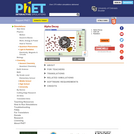
Watch alpha particles escape from a polonium nucleus, causing radioactive alpha decay. See how random decay times relate to the half life.
- Subject:
- Physical Science
- Material Type:
- Simulation
- Provider:
- University of Colorado Boulder
- Provider Set:
- PhET Interactive Simulations
- Author:
- Carl Wieman
- Danielle Harlow
- John Blanco
- Kathy Perkins
- Noah Podolefsky
- Ron LeMaster
- Sam McKagan
- Wendy Adams
- Date Added:
- 07/21/2011

This course explores the physical processes that control Earth's atmosphere, ocean, and climate. Quantitative methods for constructing mass and energy budgets. Topics include clouds, rain, severe storms, regional climate, the ozone layer, air pollution, ocean currents and productivity, the seasons, El Nio, the history of Earth's climate, global warming, energy, and water resources.
- Subject:
- Atmospheric Science
- Physical Science
- Material Type:
- Full Course
- Provider:
- Yale University
- Provider Set:
- Open Yale Courses
- Author:
- Ronald B. Smith
- Date Added:
- 04/30/2012
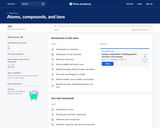
Chemistry is the study of matter, and all matter is made up of atoms. We will learn about elements, atomic number and mass, isotopes, moles (chemistry moles, not the animal), and compounds.
- Subject:
- Chemistry
- Physical Science
- Material Type:
- Lesson
- Provider:
- Khan Academy
- Provider Set:
- Khan Academy
- Date Added:
- 06/26/2019

This interactive, scaffolded activity allows students to build an atom within the framework of a newer orbital model. It opens with an explanation of why the Bohr model is incorrect and provides an analogy for understanding orbitals that is simple enough for grades 8-9. As the activity progresses, students build atoms and ions by adding or removing protons, electrons, and neutrons. As changes are made, the model displays the atomic number, net charge, and isotope symbol. Try the "Add an Electron" page to build electrons around a boron nucleus and see how electrons align from lower-to-higher energy. This item is part of the Concord Consortium, a nonprofit research and development organization dedicated to transforming education through technology. The Concord Consortium develops deeply digital learning innovations for science, mathematics, and engineering. The models are all freely accessible. Users may register for additional free access to capture data and store student work products.
- Subject:
- Applied Science
- Chemistry
- Physical Science
- Physics
- Technology
- Material Type:
- Lesson
- Provider:
- Concord Consortium
- Provider Set:
- Concord Consortium Collection
- Author:
- The Concord Consortium
- Date Added:
- 05/06/2011

In this interactive activity, learners build computer models of atoms by adding or removing electrons, protons, and neutrons. It presents the orbital model of an atom: a nucleus consisting of protons and neutrons with electrons surrounding it in regions of high probability called orbitals. Guided tasks are provided, such as constructing a lithium atom and a carbon-12 atom in the fewest possible steps. The activity concludes with a model for building a charged hydrogen atom (an ion). Within each task, students take snapshots of their work product and answer probative questions. This item is part of the Concord Consortium, a nonprofit research and development organization dedicated to transforming education through technology.
- Subject:
- Applied Science
- Chemistry
- Engineering
- Physical Science
- Physics
- Technology
- Material Type:
- Lesson
- Provider:
- Concord Consortium
- Provider Set:
- Concord Consortium Collection
- Author:
- National Science Foundation
- The Concord Consortium
- Date Added:
- 05/17/2011

In this course, we will explore what makes things in the world the way they are and why, to understand the science and consider the engineering. We learn not only why the physical world behaves the way it does, but also how to think with chemical intuition, which can’t be gained simply by observing the macroscopic world.
This 2018 version of 3.091 by Jeffrey Grossman and the 2010 OCW version by Don Sadoway cover similar topics and both provide complete learning materials. This 2018 version also includes Jeffrey Grossman’s innovative Goodie Bags, Why This Matters, and CHEMATLAS content, as well as additional practice problems, quizzes, and exams.
- Subject:
- Applied Science
- Chemistry
- Engineering
- Physical Science
- Material Type:
- Full Course
- Provider Set:
- MIT OpenCourseWare
- Author:
- Grossman, Jeffrey
- Date Added:
- 09/01/2018
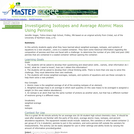
Isotopic Pennies is an activity where students use what they have learned about isotopes and weighted averages to solve a new challenge.
- Subject:
- Chemistry
- Physical Science
- Physics
- Material Type:
- Activity/Lab
- Assessment
- Lesson Plan
- Provider:
- Science Education Resource Center (SERC) at Carleton College
- Provider Set:
- Pedagogy in Action
- Author:
- Jennifer Hogan
- Date Added:
- 12/13/2011
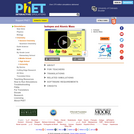
Are all atoms of an element the same? How can you tell one isotope from another? Use the sim to learn about isotopes and how abundance relates to the average atomic mass of an element.
- Subject:
- Chemistry
- Physical Science
- Material Type:
- Simulation
- Provider:
- University of Colorado Boulder
- Provider Set:
- PhET Interactive Simulations
- Author:
- Emily Moore
- John Blanco
- Kathy Perkins
- Kelly Lancaster
- Robert Parson
- Sam Reid
- Trish Loeblein
- Date Added:
- 07/18/2011
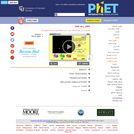
Are all atoms of an element the same? How can you tell one isotope from another? Use the sim to learn about isotopes and how abundance relates to the average atomic mass of an element.
- Subject:
- Chemistry
- Physical Science
- Material Type:
- Simulation
- Provider:
- University of Colorado Boulder
- Provider Set:
- PhET Interactive Simulations
- Author:
- Emily Moore
- John Blanco
- Kathy Perkins
- Kelly Lancaster
- Patricia Loblein
- Robert Parson
- Sam Reid
- Date Added:
- 05/13/2011

The objective of this course is to develop an understanding of principles of marine isotope geochemistry, its systematics, and its application to the study of the behavior and history of the oceans within the earth system. The emphasis is on developing the underlying concepts and theory as well as proficiency in working with practical isotope systems. The course is divided into four sections: nuclear systematics, Earth formation and evolution, stable isotopes, and applications to the ocean system.
- Subject:
- Atmospheric Science
- Physical Science
- Material Type:
- Full Course
- Provider Set:
- MIT OpenCourseWare
- Author:
- Fornace, Kyrstin
- Jenkins, Bill
- Peucker-Ehrenbrink, Bernhard
- Date Added:
- 09/01/2012
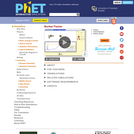
Start a chain reaction, or introduce non-radioactive isotopes to prevent one. Control energy production in a nuclear reactor! (Previously part of the Nuclear Physics simulation - now there are separate Alpha Decay and Nuclear Fission sims.)
- Subject:
- Physical Science
- Physics
- Material Type:
- Simulation
- Provider:
- University of Colorado Boulder
- Provider Set:
- PhET Interactive Simulations
- Author:
- Carl Wieman
- Danielle Harlow
- John Blanco
- Kathy Perkins
- Noah Podolefsky
- Ron LeMaster
- Sam McKagan
- Wendy Adams
- Date Added:
- 07/19/2011

Hank does his best to convince us that chemistry is not torture, but is instead the amazing and beautiful science of stuff. Chemistry can tell us how three tiny particles - the proton, neutron, and electron - come together in trillions of combinations to form ... everything. In this inaugural episode of Crash Course Chemistry, we start out with one of the biggest ideas in chemistry ever - stuff is made from atoms. More specifically, we learn about the properties of the nucleus and why they are important to defining what an atom actually is.
Chapters:
Intro
Einstein & Atoms
Composition of Atoms
Atomic Number
Isotopes
Relative Atomic Mass
Mass Number
- Subject:
- Chemistry
- Physical Science
- Material Type:
- Lecture
- Provider:
- Complexly
- Provider Set:
- Crash Course Chemistry
- Date Added:
- 02/24/2013